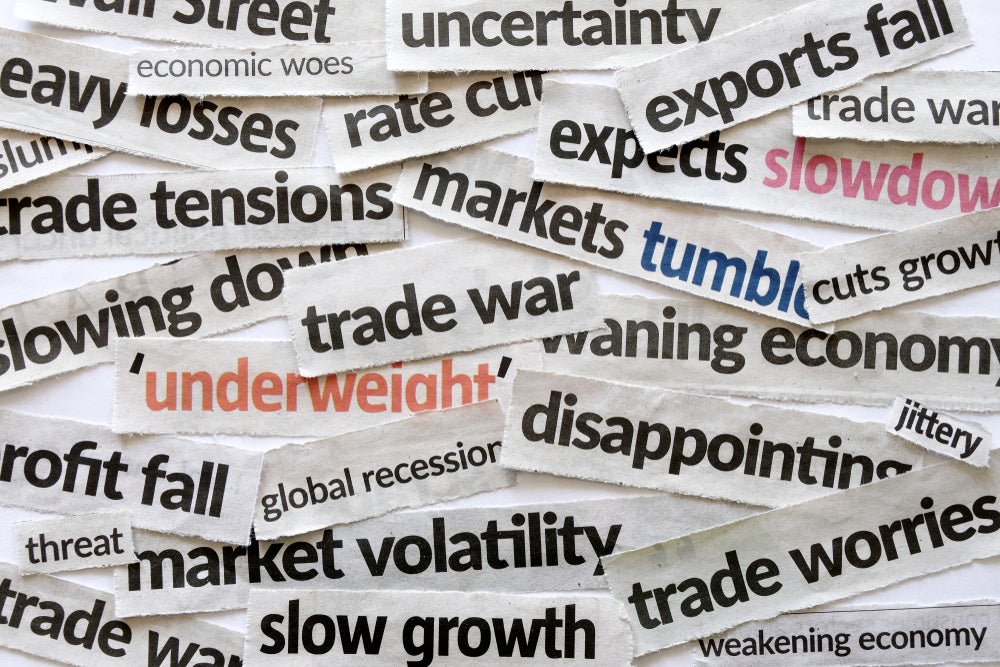
Investor confidence is unraveling at a pace not seen in years, with recession odds climbing, U.S. equity allocations collapsing and cash piles swelling, signaling one of the most bearish market outlooks in a quarter-century.
In a note shared Tuesday, Bank of America’s Michael Hartnett said April’s Global Fund Manager Survey (FMS) revealed the fifth most bearish sentiment recorded in 25 years.
With global growth expectations at 30-year lows and fears of a trade war-induced recession surging, the market narrative has flipped sharply from optimism to caution.
“The current level of sentiment is the 5th lowest on record (behind 2001, 2009, 2019 and 2022),” Hartnett wrote.
A Crash In Investor Confidence
The survey, which gathers responses from hundreds of global fund managers overseeing trillions in assets, shows net 82% of respondents expect the global economy to weaken over the next 12 months—the highest level since the survey began. This marks a dramatic deterioration from March, when only 44% held a negative growth outlook.
Recession fears are also spiking, with 42% predicting a global recession, up from 19% in March.
The probability of a “hard landing”—where economic contraction is abrupt and damaging—jumped to 49%, more than four times the 11% reported just a month earlier.
Cash levels, a proxy for investor nervousness, surged to 4.8%, up 125 basis points since February—the sharpest two-month rise since April 2020, when the pandemic panic began.
Peak US Exceptionalism?
The survey shows a seismic shift in sentiment toward U.S. markets.
Allocation to U.S. equities fell by 53 percentage points since February, the largest two-month decline on record. This pushed net underweight exposure to 36%, the lowest since May 2023.
A striking 73% of investors said the era of “U.S. exceptionalism” has peaked, referring to the belief that the U.S. economy and markets could outperform the rest of the world. Correspondingly, expectations for the U.S. dollar to depreciate hit their worst level since 2006, with 61% expecting further weakness.
Investor outlook on U.S. corporate earnings turned bleak as well—net 28% said U.S. profit expectations are negative, the most pessimistic read since November 2007, just before the global financial crisis.
Expectations On Inflation And Fed Rate Cuts Diverge
The inflation outlook took a notable hawkish turn. Net 57% of fund managers see higher global consumer price index (CPI) over the next year—the highest since June 2021. The month-over-month jump in inflation expectations, 50 percentage points, was the largest since March 2022.
Despite this, investors are betting on policy easing, with 41% expecting three or more interest rate cuts from the Federal Reserve due to tightening liquidity conditions and weakening economic activity. The largest share, 34%, forecast two cuts this year.
But Hartnett’s note cautioned that meaningful upside in asset prices would require “big tariff easing, big Fed rate cuts, and/or economic data resilience.”
The New Crowded Trade
In a notable shift, the most crowded trade among fund managers is now “long gold,” favored by 49% of respondents. This overtakes the tech-heavy “long Magnificent Seven,” which led for 24 consecutive months.
Since the start of the year, bullion, as tracked by the SPDR Gold Trust GLD, has rallied by 23%. During the same period, the US seven largest tech stocks – tracked by the RoundHill Magnificent Seven ETF MAGS – have fallen by 20%.
According to the survey, the rise of gold is tied to rising fears of stagflation—a toxic mix of slowing growth and high inflation—expected by 90% of respondents, the highest level since November 2022.
42% of fund managers also see gold as the top-performing asset for 2025, up from 23% in March. Meanwhile, global equities dropped to just 11% as the preferred asset class, a sharp decline from 39% the previous month.
How Bad Can It Get?
April’s sentiment collapse dragged Bank of America’s proprietary Bull & Bear Indicator down from 4.8 to 4.5, inching closer to the traditional “buy” zone, but still suggesting that while investors are fearful, they haven’t hit full capitulation.
Hartnett’s note also hinted at a potential contrarian setup: If tariffs are eased and the Fed delivers aggressive rate cuts, going long U.S. stocks, cyclicals and the dollar while shorting gold, bonds and defensives could pay off.
But if hard-landing fears materialize, shorting European and emerging market equities, along with bonds, would become the favored play.
Read now:
Photo: Shutterstock
© 2025 Benzinga.com. Benzinga does not provide investment advice. All rights reserved.